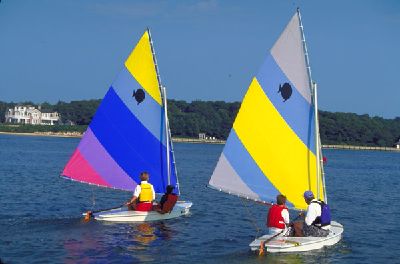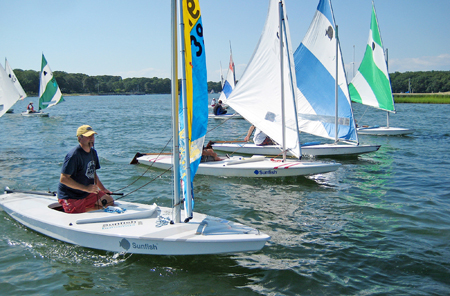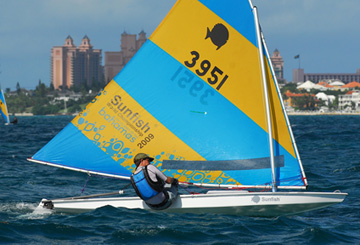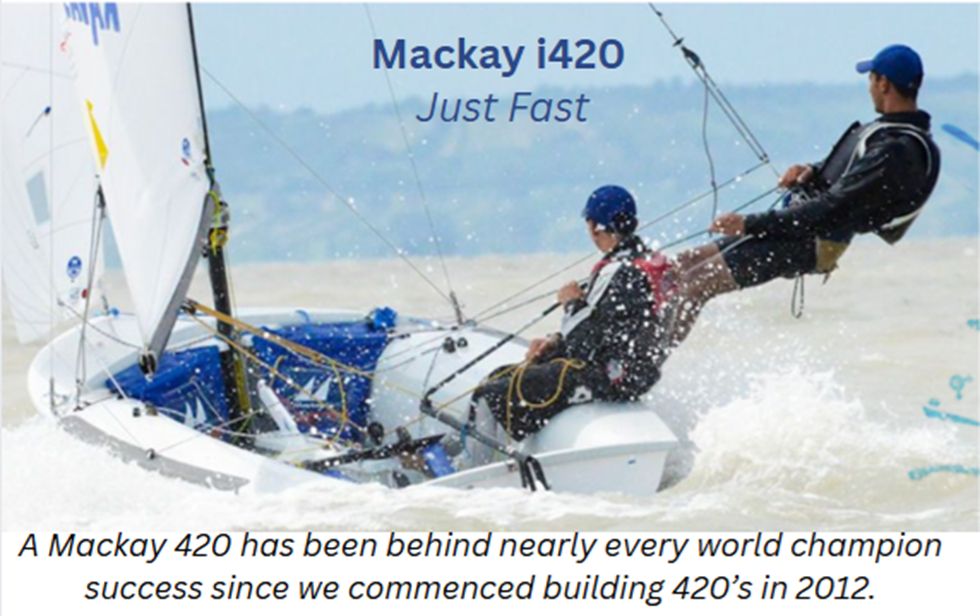Editors Note- As part of our mission to support the sailing community, Sail1Design is pleased to unveil our new series, Profiles in Pro Sailing. This series is designed to give our community thoughts, ideas, tips, and reflections on how some of the best in the industry made it to where they are today. We hope these articles are informative, and maybe even inspirational. As always, we invite comments and feedback.
By Airwaves writer Tyler Colvin
Ever since the early 1970s, performance and Farr have been synonymous in the sailing world. Bruce Farr made a name for himself in the 18’ Skiff Class of Australia and New Zealand, with Farr designs winning the 18’ Skiff Giltinan World Championships several times. Teaming up with Russell Bowler in 1980, Farr took the operation to Annapolis, MD and began churning out winners.
Around the same time, Britton Ward was sketching floor plans of houses and boats. Growing up in Western Australia, Ward watched in awe as Australia II won the America’s Cup. “…all the talk of winged keels made a big impression on me. I think I followed every race of that 1987 defense and was hooked from then on.” Said Ward. It just so happened that Bill Langan, designer of America II (NYYC), was a family friend and told him about the Webb Institute.
In 1991, Ward picked up everything and moved halfway around the world to attend the Webb Institute. He received his BSc in Naval Architecture and Marine Engineering in 1995, after which he headed to MIT for his Master’s in Ocean Engineering. “(The) most challenging part was probably moving halfway around the world at 17 to attend Webb. It was a big step but I think it set me up for my career better than I could have imagined.” After graduation, Farr happened to be hiring candidates with Ward’s background. 19 years later, he’s still at it.
Farr Yacht Design has been one of the driving forces behind performance yachting over the past several decades. Notable designs include America’s Cup yachts for New Zealand in ’87, ’88, and ’92, Young America in ’00, and BMW Oracle in ’03 and ’07, as well as super Maxi’s and now famous one-design classes. Many of the iconic high performance monohulls raced today are Farr designs, TP 52, GP42, Volvo Ocean 70, Volvo Ocean 65, Volvo Ocean 60, Mumm 36, Mumm 30 and the Farr 40 to name a few. Additionally, Bavaria and Beneteau have both commissioned designs for their fleets from Farr.
Ward’s work spans the entirety of the design process. “A lot of my work is focused on the conceptual design, hull shape development and performance prediction side of the design process and that can take me from fairing a 3D hull shape to setting up computational simulations or refining VPP algorithms and a lot in between.” While a mouthful, in short he works on figuring out how to make boats faster. “Life in a yacht design office can be pretty varied on a day to day basis and the tasks can vary a lot. Some of our employees may be drafting a fitting or doing structural engineering and weight calculations while others are working on handicap optimization for existing designs or designing new rudders or keels.”
After 19 years in the industry, Ward remains focused and intrigued by his work. “There is something very pure about designing boats… that’s always fascinated me. You need to develop a product that often has to meet many different design objectives all while being as efficient as possible both aero and hydrodynmically but also optimized structurally for weight, strength and manufacturing.” Putting together this puzzle is what makes a great boat, and full concept understanding is a key component. “In a lot of industries you might work in a little big of isolation, designing a little piece here or there and a project might take years to come to fruition. But with the yacht design problem we have tight time frames and you need to be able to wrap your head around the whole design challenge, as everything is so tightly inter-related. When your team pulls all the pieces of a design together into something that exceeds all those expectations it can be pretty rewarding.”
Ward takes great pride in his work and is excited to tackle a new challenge. “The (project) one that looms largest right now is the VO65 for which I was lead designer. The challenge of a short design and build time, big performance expectation, tight cost control and incredibly tight tolerances and reliability requirements is like nothing I’ve worked on before. Watching them send it though the Southern Ocean this month has been nerve wracking for sure but I’m really proud of how close the racing is and that they seem to have delivered on so many of the often conflicting design objectives.”
Every young sailor at one point or another has sketched boats in a notebook or on the sand; big, small, sailboats and motorboats, in crayon, marker, pencil or pen, in corners of lined paper or on the back of an assignment. It is the imagination of a young mariner at work. Britton Ward’s imagination transformed into an unbelievably productive career at one of the most successful yacht design firms in the business. While degrees from Webb and MIT might not be your chosen path, he explains, “The more technical paths need college or graduate school level engineering but others require advanced software skills and real world experience. Everyone needs a lot of creativity and has to have a passion for pushing the envelope and developing unique design solutions.” Dream big and keep drawing.
Blog
Club Profile: Tiverton Yacht Club
The Tiverton Yacht Club is a small family oriented yacht club on the Sakonnet River in Tiverton. We have a full sailing program (sail training, racing and cruising) with a twenty-one slip marina, dingy docks and storage racks and moorings in the Tiverton basin. We have a swimming pool, full social calendar and great views of the bay and beautiful sunsets.
News Flash: Tiverton Yacht Club is hiring a Sailing Instructor!
The club is busy preparing for the 2015 summer season. We are fixing, cleaning and getting club ready for summer. We have many activities planned for young and old alike.

TYC has an active adult racing program for cruising class yachts. TYC recently joined forces with the Spar Island Racing Association, which enables larger fleets, more varied competition and more fun all around. During the summer, Wednesday evening races start at 6:30. Participation is encouraged at all skill levels. Boats ranging from 23 feet to over 40 feet competed. These are handicap races using the Performance Handicap Rating System. A current PHRF certificate is required. Boats are divided into three classes depending upon PHRF rating. Racers in any class may chose to race on any given day with or without spinnaker and the appropriate rating will be applied. This is a superb rule which encourages people of all skill levels to get out and race and progress.
News Flash: Tiverton Yacht Club is hiring a Sailing Instructor!
Testimonials:
“The Tiverton Yacht Club is wonderful program. Led by Meredith Collins it get’s back to the basics and genuinely teaches kids to love the water, sailing and each other. In the this world of overly competitive everything, this is a welcome oasis of great camaraderie” – Mike Zani
“I am forever grateful for the skills and knowledge I acquired while participating, then teaching in the program. The positive experiences I had in at the TYC influenced and eventually led me to a career in the marine industry.” -Brendan Prior
Club Profile: Sandy Bay Yacht Club
By Airwaves writer Tyler Colvin
The North Shore of Boston, Massachusetts offers some of the most historic boating in the country. From Nahant to Ipswich, there is a wealth of sailing to be had. On the tip of Cape Ann is Sandy Bay Yacht Club, in scenic Rockport, Massachusetts.
Operating since 1885, Sandy Bay Yacht Club has been in its current clubhouse on the end of T-Wharf since 1930. From, 100 Years of Sailing at Sandy Bay, “In 1885 Annisquam challenged Rockport to a race around Thacher’s. Annisquam must have had an organization to issue the challenge; Rockport must have had one to accept it. So we say a sailing club, from which ours is descended, existed here in 1885.”
Sandy Bay is a large bay on the tip of Cape Ann measuring about a mile long and one and a half miles wide. Average depth is around 60’ and is partially enclosed by a WWII era breakwater. In the summer it features a strong southerly sea breeze very consistently with temperatures in the high 70s/low 80s. Of all the locations on the North Shore, Sandy Bay has by far the most consistent wind. While tourist driven income is still a staple in the town, fishing and lobstering are still prevalent.
The yacht club itself sits out on the end of T-Wharf at the heart of downtown Rockport. It is home to the Cape Ann Star Fleet, as well as several healthy one-design classes such as the Bullseye, Flying Scot and Rhodes 19. There are about 800 members ranging from ages 8 to 95, all of whom participate in some capacity in the sailing, recreational boating, and social activities at the club. Membership dues are very reasonable and provide access to all the facilities, including one of the best decks in Rockport to sit back and relax. One thing it does not guarantee however is mooring or dockage, as both are at a premium.
In addition to the facilities, Sandy Bay Yacht Club also has adult and junior learn to sail and race programs. The SBYC Junior Sailing program is a 501(c)(3) charity and caters to youth from all around Cape Ann. A couple hundred kids pass through the program each summer and make use of the 18 club-owned Optis as well as 9 club-owned C420s. Lessons run for 10 weeks in the summer as groups, and private lessons at any time in the dinghies or in a club owned Rhodes 19 or Bullseye by one of the very qualified instructors.
Sandy Bay Yacht Club is the perfect place to get away from the city life and enjoy the best the North Shore has to offer. Several beaches, countless excellent restaurants and the Yacht Club are all within walking distance of each other. So pack up the car or jump on the train and head north on 128 to beautiful Rockport and Sandy Bay Yacht Club.
ICSA TEAM RACE RANKINGS #2 of Spring 2015!
Yale holds the top spot, followed by Boston College, and College of Charleston. Check out the latest rankings!
Selden US News: The i420 Mast
For years sailors in Europe have enjoyed the luxury of personalizing their mast and rig setup to best suit conditions and the team’s sailing weight.
That performance advantage is now available to sailors in the United States via Seldén Mast Inc. headquartered in Charleston, SC.
Seldén offers THREE rig packages which allow sailors to choose their ideal mast characteristics dependent on the weight of the team. These options are highly valuable as Seldén propelled nine of the top fifteen finishers at the 2014 European Championship event where 108 teams competed.
Seldén has been building masts since 1960 when founder Per Seldén first looked to replace his wooden dinghy mast with aluminum. Today Seldén now leads the way in producing top quality aluminum and carbon fiber rigs around the world for boats ranging in size and performance from the Optimist to large luxury yachts. In addition to masts they also have a complete range of deck hardware which makes them the only single company able to outfit an entire boat from the deck-up.
In the United States, top level collegiate programs including MIT, Coast Guard, Eckerd, Brown, Yale, and Christopher Newport look to Seldén to provide customized top performing 420 and FJ rigs to meet their unique needs.
For more information on the US Youth Championship Regatta see:
http://www.ussailing.org/racing/championships/youth/youthchamps/
For Seldén Mast Dinghy information or to purchase spars, rigging & deck hardware call Seldén Mast Inc. at 843-760-6278 or email [email protected].
One Design Class Profile: Sunfish
There may not be a more iconic or well-known sailboat than the Sunfish. Since 1952, hundreds of thousands of hulls have hit the water in bays, lakes, ponds and rivers around the world. One of, if not the, most popular boat ever built, the Sunfish has provided countless families with hours of summer fun on the water.
The Boat
Offered initially as a kit boat, the Sunfish grew from the Sailfish design by Alex Bryan and Cortlandt Heyniger. At 13’ 9” long, 4’1” wide and drawing 2’11”, the Sunfish weighs in at 120lbs and is easily transported by car top or trailer. It features a Lateen style rig and shallow v-shaped fully sealed hull. This makes the boat particularly beginner-friendly because despite fully swamping, it will not sink. Additionally the low-aspect Lateen rig helps the boat perform well in light air and off the wind.
Roger Williams University Head Coach Amanda Callahan has fully embraced the Sunfish class and thrived with top finishes at local, regional and national events, as well as qualifying for the 2015 Worlds. “After crewing in team racing for years, I was really looking to get back to driving,” says Callahan, “I’m 5’3”, and there aren’t a lot of affordable boats that I can skipper. I’m on the small side for a radial, and I wasn’t too excited about sailing against the Laser 4.7 crowd. I like that I can be competitive in the boat until 14 knots…”
While there is a strong Sunfish racing fleet, it is not the primary use for the boat. Of the 300,000+ boats that have been produced, there are only fraction (<2000) Sunfish class members. This is a testament to the flexibility of the platform. “On Sunfish you can raise your halyard up to get the boom way off the deck and bring 3 of your friends out on the water for a fun afternoon,” said Callahan on the recreational benefits of the Sunfish.
Class Association
Everyone everywhere sails the Sunfish. You are just as likely to find a racing fleet in Peru as you are to finding a relegated hull in a New England back yard. Internationally the Sunfish is raced across North America, South America and parts of Europe. Within the US, there are strong fleets in New England, Chicago, Texas, New York, California and the Gulf Coast.
Callahan got her Sunfish start in New England, “One of the members, Jack Willy, of the club where I grew up (Wessagusett Yacht Club), suggested that we (my friend Kate and I) try out the Sunfish. He lent us some boats for a couple of regattas down the Cape.” She now calls it her “retirement boat” (from competitive team racing) and hasn’t looked back.
Why Sail?
The Sunfish is a great boat for people of all ages and ability levels. “You can easily car top a ‘fish and go anywhere,” commented Callahan, ”the Sunfish was a perfect fit for me. Plus, the sunfish class is very supportive, especially my sunfish friends in NE.” She adds, “I would love to see more women get into the class. I was boat homeless for a while, and this class is my new home. Also, I know there are many college grads who don’t know where to turn to continue sailing, this is a perfect outlet.” Affordable and everywhere, the hundreds of thousands of Sunfish owners worldwide have to be on to something. It is an ideal platform for the casual sailor, the “retired” competitive racer, or “boat homeless” college grad.
Learn more about the Sunfish Class History


















